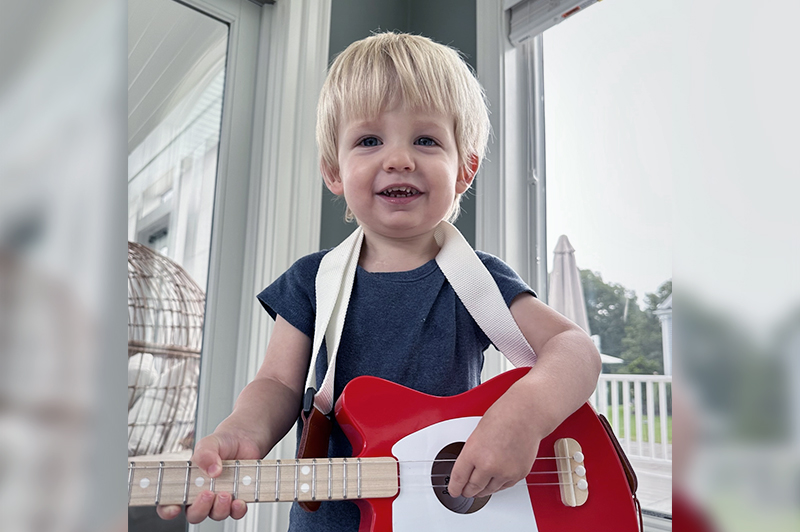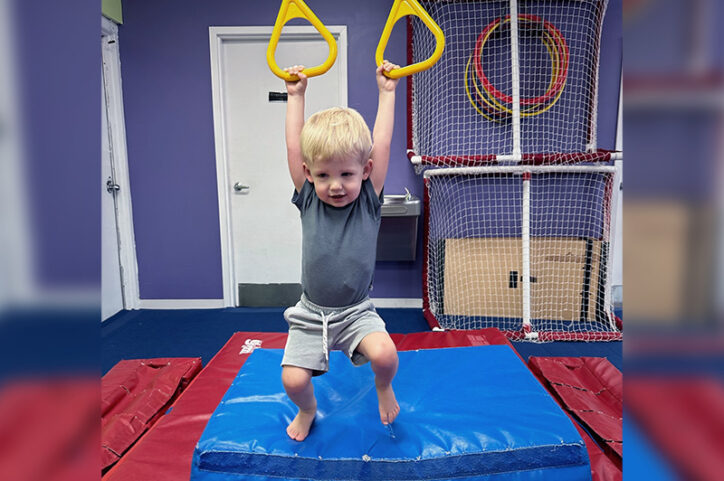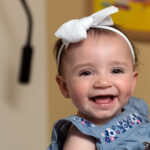From ECMO to an active childhood: Nolan’s journey with congenital diaphragmatic hernia

Nolan Griffin knows how to use a stethoscope and rarely enters Boston Children’s Hospital without his medical kit. But Nolan isn’t a doctor — at least not yet. For now, the busy 2-year-old is a patient in the hospital’s Congenital Diaphragmatic Hernia Center, where he’s been receiving care since before he was born.

An unexpected diagnosis
Nolan’s mother, Staci, was at her 20-week ultrasound when she learned that her son would be born with a congenital diaphragmatic hernia (CDH). In this condition, the diaphragm — the layer of muscle between the chest and abdominal cavity — does not close completely, leaving a hole. As a result, the intestines and other abdominal organs can move into the chest, which prevents normal lung development.
“It was devastating to learn and a lot to process,” says Staci. She and her husband, Brian, were immediately referred to Boston Children’s Maternal Fetal Care Center (MFCC), which is affiliated with their birth hospital, Brigham and Women’s Hospital. There, they met surgeon Dr. Jill Zalieckas, who co-directs the CDH Center, and maternal-fetal medicine specialist Dr. Yael Hoffman Sage.
“They explained the whole spectrum of CDH and the different scenarios we might expect,” says Brian. Although the couple hoped that the anomaly would be mild to moderate, they understood that the care team wouldn’t know the true severity of the condition until Nolan was born.

Feeling scared — but grateful
When his heart rate dropped after Staci was induced, Nolan was delivered quickly via an emergency C-section. “It was very intense,” remembers Staci. Although she and Brian admit that the next few days were a blur, they were grateful to be surrounded by the team from the MFCC and CDH Center during the delivery — and again as Nolan underwent surgical CDH repair with Dr. Zalieckas.
The surgery was a success, but it revealed that Nolan’s CDH was more severe than the Griffins had hoped: He had a type C defect, which meant that the hole in his diaphragm was large. Following surgery, Nolan remained on extracorporeal membrane oxygenation (ECMO), an advanced technology that supports the function of the heart and lungs, allowing time for his lungs to grow and for him to recover from surgery.
All told, Nolan spent about three weeks on ECMO and 28 days intubated until he could breathe on his own. “They were the scariest three weeks of our lives,” says Brian. “We knew that the longer a baby is on ECMO, the greater the chance for complications. But we trusted in our Boston Children’s team and took each day minute by minute.” That team also included CDH Center co-director Dr. Belinda Dickie and nurse practitioner Lindsay Lemire, whose constant communication with the family helped them stay calm — and hopeful.

A testament to his care
When Nolan was finally ready, his removal from the ECMO machine was marked by relief and cautious optimism. After being in the medical-surgical intensive care unit (MSICU) for five weeks, he moved to an inpatient room, where the CDH Center team continued to support his progress. That included working to wean him off supplemental oxygen and helping him learn how to feed by mouth. Nolan’s hard work paid off: After 66 days, he was finally able to go home.
“We’re forever grateful to the CDH, ECMO, MSICU, and inpatient teams, who went above and beyond to ensure the best possible care for Nolan,” says Brian. “We often had doctors and nurses who had previously cared for Nolan stop by even when they weren’t assigned to us, just to check in on his progress and us as parents. We can’t understate how much of a positive impact that had.”
Today, Nolan sees pulmonologists, cardiologists, neurologists, audiologists, and other specialists throughout Boston Children’s to monitor his development after a prolonged hospital course. While he still relies on a g-tube to stay hydrated, he’s now able to eat by mouth. And he’s graduated to annual checkups in the CDH Center, although his parents keep in touch with the team to address any concerns as they arise.
When he’s not playing with his toy medical kit or singing and dancing to his favorite Disney song, he’s showering his family — including a new baby sister — with hugs and kisses. “If you didn’t know his story, you wouldn’t be able to tell what he’s been through,” says Brian. “And that’s a real testament to the care he’s received.”
Learn more about the Congenital Diaphragmatic Hernia Center.
Related Posts :
-

Making it through the fight: Scarlett's CDH journey
Like her name suggests, Scarlett Virginia Moulton “has a lot of fire,” says her mother, Olivia. “She always has a ...
-

‘Our silver lining’: Mila is thriving after CDH repair
For Katie, last St. Patrick’s Day wasn’t an occasion for revelry. Instead, it was the day an ultrasound ...
-

From Cape Verde for coordinated CDH care
Most parents have never heard of congenital diaphragmatic hernia (CDH), a rare and potentially life-threatening condition in which a baby ...
-

Incredible Teddy: Thriving with CDH
Andi Lodico left for the hospital at 1 a.m., in labor with her second child. She didn’t return home ...





